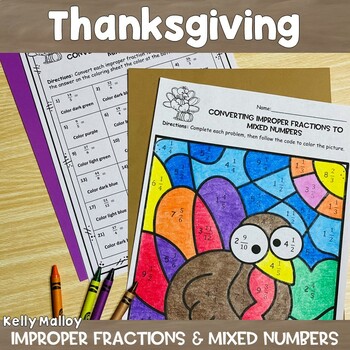Converting Improper Fractions to Mixed Numbers Turkey Coloring Page
Kelly Malloy An Apple for the Teacher
11k Followers
Grade Levels
4th - 6th
Subjects
Resource Type
Standards
CCSS4.NF.A.2
CCSS5.NF.A.1
CCSS4.NF.C.7
Formats Included
- PDF
Pages
18 pages
Kelly Malloy An Apple for the Teacher
11k Followers
Description
Make converting mixed numbers to improper fractions and improper fractions to mixed numbers more engaging and colorful with this Thanksgiving color by number activity!
This is great as a center activity, fast finisher activity, homework or even an assessment.
Students solve 16-24 problems and then color.
Check out the preview above to see what's included.
Problems require students to:
- Convert improper fractions to mixed numbers
- Convert mixed numbers to improper fractions
- Compare improper fractions and mixed numbers with common denominators
Total Pages
18 pages
Answer Key
Included
Teaching Duration
30 minutes
Report this resource to TPT
Reported resources will be reviewed by our team. Report this resource to let us know if this resource violates TPT’s content guidelines.
Standards
to see state-specific standards (only available in the US).
CCSS4.NF.A.2
Compare two fractions with different numerators and different denominators, e.g., by creating common denominators or numerators, or by comparing to a benchmark fraction such as 1/2. Recognize that comparisons are valid only when the two fractions refer to the same whole. Record the results of comparisons with symbols >, =, or <, and justify the conclusions, e.g., by using a visual fraction model.
CCSS5.NF.A.1
Add and subtract fractions with unlike denominators (including mixed numbers) by replacing given fractions with equivalent fractions in such a way as to produce an equivalent sum or difference of fractions with like denominators. For example, 2/3 + 5/4 = 8/12 + 15/12 = 23/12. (In general, 𝘢/𝘣 + 𝘤/𝘥 = (𝘢𝘥 + 𝘣𝘤)/𝘣𝘥.)
CCSS4.NF.C.7
Compare two decimals to hundredths by reasoning about their size. Recognize that comparisons are valid only when the two decimals refer to the same whole. Record the results of comparisons with the symbols >, =, or <, and justify the conclusions, e.g., by using a visual model.





